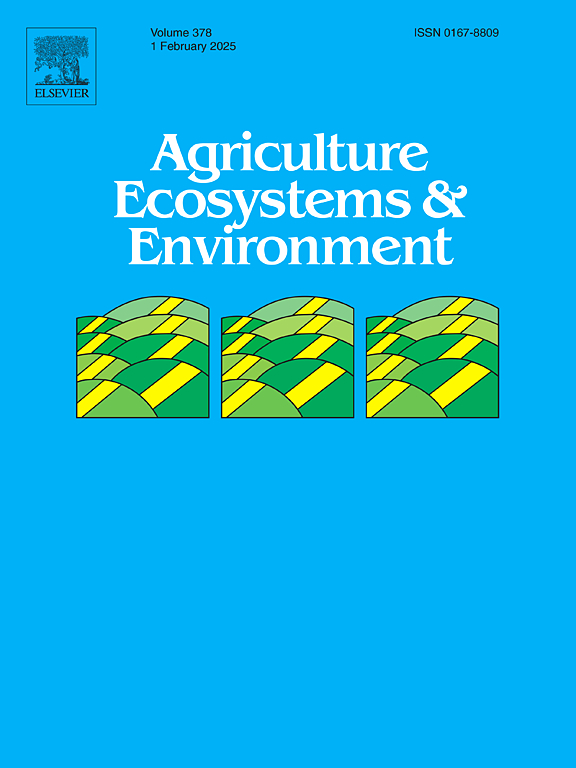Straw return strategies for soil microbial quotient enhancement: Insights from DOM vertical distribution characteristics
IF 6
1区 农林科学
Q1 AGRICULTURE, MULTIDISCIPLINARY
引用次数: 0
Abstract
The soil microbial quotient (SMQ), a critical indicator of agricultural soil quality, exhibits significant responsiveness to dissolved organic matter (DOM). However, how the heterogeneity of DOM characteristics regulates the SMQ remains unclear, despite DOM being a critical energy source for microorganisms. We conducted a field experiment with four treatments: conventional tillage (CT), no-tillage with straw mulch (NTS), conventional tillage with straw mulch and incorporation (CTS), and deep tillage with straw incorporation (DTS), with soil samples collected at four depth intervals (0–10, 10–20, 20–30, and 30–40 cm) to investigate how DOM characteristics influence SMQ. The results indicated that SMQ declined with soil depth. Straw return enhanced SMQ, with effectiveness ordered as CTS > NTS > DTS > CT. Compared to CT, straw return increased the content and humic-like components of DOM. Additionally, NTS and CTS accelerated depth-dependent variations in protein-like substances, whereas DTS promoted those in humic-like substances. Linear regression analysis showed that SMQ was positively correlated with both dissolved organic carbon and humic-like components of DOM. Random Forest analysis showed that soil enzyme activities and nutrients dominated SMQ regulation in the 0–20 cm layer, while DOM characteristics governed SMQ in the 20–40 cm layer. Among all treatments, CTS was identified as the most effective in enhancing SMQ. These findings elucidate the DOM-mediated mechanism of SMQ regulation under straw return, providing a scientific basis for optimizing agricultural management practices.
提高土壤微生物商的秸秆还田策略:来自DOM垂直分布特征的启示
土壤微生物商(SMQ)是农业土壤质量的重要指标,对土壤溶解有机质(DOM)具有显著的响应性。然而,尽管DOM是微生物的重要能量来源,但DOM特征的异质性如何调节SMQ仍不清楚。通过常规耕作(CT)、免耕秸秆覆盖(NTS)、常规耕作秸秆覆盖还田(CTS)和秸秆还田深耕(DTS) 4种处理,在0-10、10-20、20-30和30-40 cm 4个深度间隔采集土壤样品,研究DOM特征对SMQ的影响。结果表明,SMQ随土层深度的增加而减小。秸秆还田提高SMQ,效果顺序为CTS >;nt祝辞DTS祝辞CT。与CT相比,秸秆还田增加了DOM的含量和腐殖质样成分。此外,NTS和CTS加速了蛋白质样物质的深度依赖性变化,而DTS促进了腐殖质样物质的深度依赖性变化。线性回归分析表明,SMQ与DOM中溶解有机碳和类腐殖质组分均呈正相关。随机森林分析表明,0 ~ 20 cm土层SMQ调控以土壤酶活性和养分为主,而20 ~ 40 cm土层SMQ调控以DOM特征为主。在所有治疗中,CTS被认为是增强SMQ最有效的。这些发现阐明了秸秆还田条件下dom介导的SMQ调控机制,为优化农业管理实践提供了科学依据。
本文章由计算机程序翻译,如有差异,请以英文原文为准。
求助全文
约1分钟内获得全文
求助全文
来源期刊

Agriculture, Ecosystems & Environment
环境科学-环境科学
CiteScore
11.70
自引率
9.10%
发文量
392
审稿时长
26 days
期刊介绍:
Agriculture, Ecosystems and Environment publishes scientific articles dealing with the interface between agroecosystems and the natural environment, specifically how agriculture influences the environment and how changes in that environment impact agroecosystems. Preference is given to papers from experimental and observational research at the field, system or landscape level, from studies that enhance our understanding of processes using data-based biophysical modelling, and papers that bridge scientific disciplines and integrate knowledge. All papers should be placed in an international or wide comparative context.
 求助内容:
求助内容: 应助结果提醒方式:
应助结果提醒方式:


